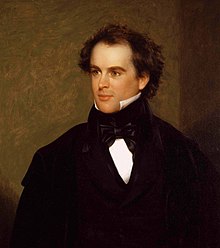Teacher’s Summary: In this literature essay, a student explores Nathaniel Hawthorne’s ‘Young Goodman Brown,’ uncovering the rich symbolism and deeper meanings within the story. The essay begins with a brief overview of Hawthorne and the tale itself, before delving into the myriad symbols present, such as the forest, Faith’s pink ribbons, and the serpent-like staff. Through these symbols, the student examines the characters and their representations, highlighting the story’s exploration of faith, temptation, and the loss of innocence. This engaging analysis demonstrates the timeless relevance of Hawthorne’s work, encouraging readers to reflect on their own experiences and the complexities of human nature.
Unraveling the Mystery of “Young Goodman Brown”: My Journey into Hawthorne’s Dark Forest
Introduction
When my English teacher assigned us Nathaniel Hawthorne’s “Young Goodman Brown,” I thought, “Great, another boring old story.” But as I started reading, I realized this wasn’t just any tale – it was like stepping into a creepy, fascinating dream that I couldn’t wake up from. Let me take you on my journey through Hawthorne’s dark forest of symbols and hidden meanings.

Who Was Nathaniel Hawthorne?
Before diving into the story, I did some digging on Hawthorne. Turns out, he was this 19th-century writer from Salem, Massachusetts (yep, the place with the witch trials). He was big on using allegory and symbolism in his stories, which basically means everything has a hidden meaning. It’s like he’s playing a game of hide-and-seek with the reader, and we’ve got to find all the clues!
The Story: A Quick Rundown
So, “Young Goodman Brown” is about this guy (surprise, his name is Young Goodman Brown) who lives in a Puritan village. One night, he decides to take a walk in the forest, leaving behind his wife, Faith. In the forest, he meets all sorts of creepy characters and discovers that everyone in his village, including his wife, might be secretly evil. When he returns, he’s a changed man – and not in a good way.
Symbols Everywhere!
As I read, I started seeing symbols pop up everywhere. It was like putting on 3D glasses – suddenly, everything had an extra layer of meaning. Here are some of the cool ones I spotted:
- The Forest: It’s not just any woods. This forest is like the dark side of the moon – a place where all the secret, scary stuff happens. It made me think of those times when I’m alone with my thoughts, and suddenly all my fears and doubts creep in.
- Faith’s Pink Ribbons: Brown’s wife, Faith, wears these pink ribbons. At first, I thought it was just a fashion choice, but then I realized it’s way deeper. The ribbons are like Faith’s innocence and purity. When Brown finds one in the forest, it’s like seeing innocence corrupted. It reminded me of when I first realized my parents weren’t perfect – that mix of disappointment and growing up.
- The Staff: The creepy old man in the forest has this staff that looks like a snake. Hello, Garden of Eden reference! It’s like Hawthorne is saying, “Watch out, temptation ahead!”
Characters as Symbols
What blew my mind was how even the characters are symbols:
- Young Goodman Brown: He’s not just the main character; he represents every person facing a crisis of faith. I could relate to his struggle – like when I started questioning things I’d always believed in.
- Faith: Brown’s wife isn’t just a character; she’s literally his faith personified. When he doubts her, he’s doubting his own beliefs. It made me think about how our relationships often reflect our inner struggles.
- The Mysterious Stranger: This creepy dude in the forest? Totally the devil. But he’s also the voice of temptation we all have inside us.
The Big Questions
As I finished the story, my head was spinning with questions:
- Was it all just a dream? Or did it really happen?
- If everyone’s secretly evil, does that mean we’re all doomed?
- Is it better to be naïve and happy, or aware and miserable?
I realized these are questions we all grapple with as we grow up. It’s like Hawthorne took the experience of losing innocence and turned it into a spooky forest adventure.
Conclusion: Why It Matters
At first, I thought this was just some old story we had to read for class. But now, I see it differently. “Young Goodman Brown” is like a mirror – it shows us the dark parts of ourselves and our society that we often try to ignore. It’s about the moment we realize the world isn’t black and white, but shades of gray.
Reading this story made me think about my own “journey into the forest” – those times when I’ve faced my doubts and fears. It’s not always comfortable, but it’s part of growing up. Hawthorne might have written this almost 200 years ago, but the struggles he talks about are still super relevant today.
So next time someone tells you old literature is boring, tell them to take a walk in Hawthorne’s forest. They might be surprised at what they find – not just about the story, but about themselves.
Work Cited:
1.Hawthorne, N. (1835). Young Goodman Brown.
2. Colacurcio, M. J. (1984). The Province of Piety: Moral History in Hawthorne’s Early Tales. Duke University Press.
3. Fogle, R. H. (1969). Hawthorne’s Fiction: The Light and the Dark. University of Oklahoma Press.
4. Milder, R. (1993). Reimagining Thoreau. Cambridge University Press.
5.Cambridge University Press. (2017). Hawthorne and His Mosses: Symbolism and Allegory.